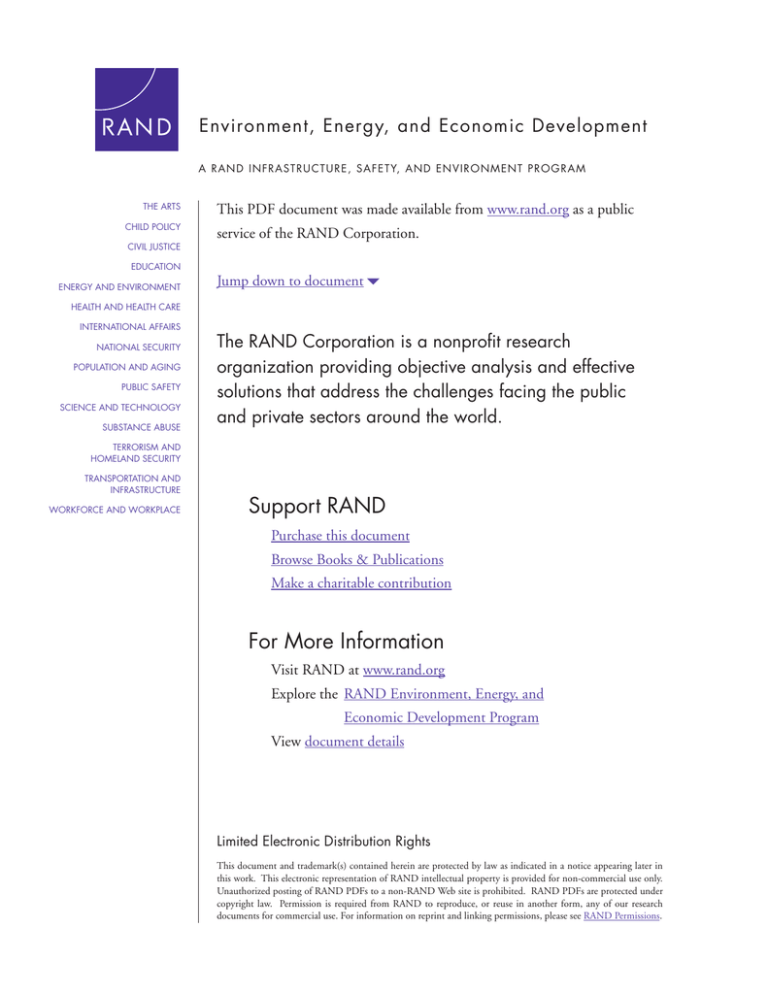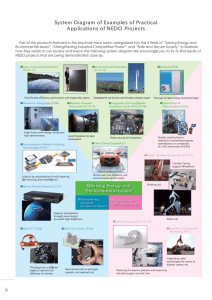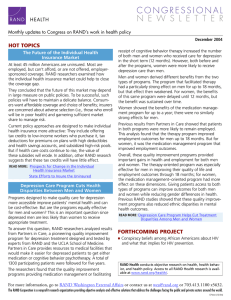
Environment, Energy, and Economic Development
A R A N D I N F R A S T R U C TURE, SAFETY, AND ENVIRONMENT PROGRAM
THE ARTS
CHILD POLICY
CIVIL JUSTICE
EDUCATION
ENERGY AND ENVIRONMENT
This PDF document was made available from www.rand.org as a public
service of the RAND Corporation.
Jump down to document6
HEALTH AND HEALTH CARE
INTERNATIONAL AFFAIRS
NATIONAL SECURITY
POPULATION AND AGING
PUBLIC SAFETY
SCIENCE AND TECHNOLOGY
SUBSTANCE ABUSE
The RAND Corporation is a nonprofit research
organization providing objective analysis and effective
solutions that address the challenges facing the public
and private sectors around the world.
TERRORISM AND
HOMELAND SECURITY
TRANSPORTATION AND
INFRASTRUCTURE
WORKFORCE AND WORKPLACE
Support RAND
Purchase this document
Browse Books & Publications
Make a charitable contribution
For More Information
Visit RAND at www.rand.org
Explore the RAND Environment, Energy, and
Economic Development Program
View document details
Limited Electronic Distribution Rights
This document and trademark(s) contained herein are protected by law as indicated in a notice appearing later in
this work. This electronic representation of RAND intellectual property is provided for non-commercial use only.
Unauthorized posting of RAND PDFs to a non-RAND Web site is prohibited. RAND PDFs are protected under
copyright law. Permission is required from RAND to reproduce, or reuse in another form, any of our research
documents for commercial use. For information on reprint and linking permissions, please see RAND Permissions.
This product is part of the RAND Corporation technical report series. Reports may
include research findings on a specific topic that is limited in scope; present discussions of the methodology employed in research; provide literature reviews, survey
instruments, modeling exercises, guidelines for practitioners and research professionals, and supporting documentation; or deliver preliminary findings. All RAND
reports undergo rigorous peer review to ensure that they meet high standards for research quality and objectivity.
Estimating the Value of
Water-Use Efficiency in the
Intermountain West
David G. Groves, James Griffin, Sara Hajiamiri
Sponsored by the William and Flora Hewlett Foundation
Environment, Energy, and Economic Development
A RAND INFRASTRUCTURE, SAFETY, AND ENVIRONMENT PROGRAM
The research described in this report was sponsored by the William and Flora Hewlett
Foundation and was conducted under the auspices of the Environment, Energy, and
Economic Development Program (EEED) within R AND Infrastructure, Safety, and
Environment (ISE).
Library of Congress Cataloging-in-Publication Data
Groves, David G.
Estimating the value of water-use efficiency in the Intermountain West / David G. Groves, James Griffin,
Sara Hajiamiri.
p. cm.
Includes bibliographical references.
ISBN 978-0-8330-4397-9 (pbk. : alk. paper)
1. Water resources development—California. 2. Water-supply—California. I. Griffin, James.
II. Hajiamiri, Sara. III. Title.
TC425.M66C35 2008
363.6'10979—dc22
2007052725
The RAND Corporation is a nonprofit research organization providing objective analysis
and effective solutions that address the challenges facing the public and private sectors
around the world. RAND’s publications do not necessarily reflect the opinions of its
research clients and sponsors.
R® is a registered trademark.
© Copyright 2008 RAND Corporation
All rights reserved. No part of this book may be reproduced in any form by any electronic or
mechanical means (including photocopying, recording, or information storage and retrieval)
without permission in writing from RAND.
Published 2008 by the RAND Corporation
1776 Main Street, P.O. Box 2138, Santa Monica, CA 90407-2138
1200 South Hayes Street, Arlington, VA 22202-5050
4570 Fifth Avenue, Suite 600, Pittsburgh, PA 15213-2665
RAND URL: http://www.rand.org
To order RAND documents or to obtain additional information, contact
Distribution Services: Telephone: (310) 451-7002;
Fax: (310) 451-6915; Email: order@rand.org
Summary
Increasing water-use efficiency is an important management strategy for western water agencies. Evaluating the cost effectiveness of water-efficiency programs relative to supply-enhancement measures can be difficult, however, because not all the benefits of improved efficiency
are easily quantified. Tangible, future benefits, such as avoided costs, not only depend on the
details of complex management systems, but can also be strongly influenced by future uncertainties that are difficult to characterize. Other nontangible benefits, such as supply reliability
and avoided environmental impacts, are difficult to quantify due to a lack of standardized
methodologies; poor data availability; and multiple, competing values over outcomes. Without
good estimates of efficiency-program cost effectiveness, it may be difficult to identify appropriate efficiency programs for implementation.
This report utilizes two recently released tools by the California Urban Water Conservation Council—the avoided-cost model (AC model) and the environmental-benefit model (EB
model)—to estimate the benefits of water use–efficiency programs in the Denver Water service
area. The AC model is customized to reflect the short-run (SR) and long-run (LR) incremental
benefits of water-use reduction on Denver Water’s three water-collection systems—the South
Platte River, the Roberts Tunnel system, and the Moffat system. We then use the methodological approach developed for the EB model to estimate the benefits of water-use efficiency to the
environmental and recreational services. Specifically, we evaluate benefits to riparian and wetland habitat, air quality, recreational river fishing, and recreational river rafting. Together, the
estimated avoided costs and environmental benefits comprise a more complete representation
of the value of efficiency than water agencies often use, by comparing efficiency to other water
supply–enhancing options.
The methodologies employed require significant simplifications of the water systems
under evaluation and the use of uncertain estimates of the causal effects of water-use reduction and environmental and recreational benefits. To accommodate the significant uncertainties that result, we opt not to develop a single “best-guess” or likeliest estimate of the value of
efficiency. Instead, we take an exploratory modeling approach and evaluate the models under
a wide range of plausible assumptions. The results are ranges of possible efficiency benefits. We
demonstrate that, even with a wide range of results, the true value of efficiency is significantly
larger than one would estimate if only considering SR avoided costs.
Our principal findings are summarized by Figure S.1, which shows ranges of efficiency
valuation results as more benefits are accounted for. Each box-and-stem result in the figure
represents the present value (PV) of 1 million gallons of efficiency savings per year. The results
are derived from 1,000 runs of the models under a wide range of assumptions.
xi
xii
Estimating the Value of Water-Use Efficiency in the Intermountain West
Figure S.1
Present Value of Short-Run, Long-Run, and Total Avoided Costs; Short-Run, Long-Run, and Total
Environmental and Recreational Benefits; and the Sum of the Total Avoided Costs and the Total
Environmental and Recreational Benefits
SR avoided costs
Efficiency-benefit component
LR avoided costs
Total avoided costs*
SR environmental benefits
LR environmental benefits
Total environmental benefits*
Avoided costs + environmental benefits*
0
25
50
75
100
PV ($ thousands per mgal)
NOTE: Asterisks indicate summation estimates. Each box represents the results of 1,000 model runs and
shows the lower quartile (left edge), upper quartile (right edge), and median (inner line) of the results. The
dots and stems depict the remaining range of the results.
RAND TR504-S.1
For example, considering only the SR avoided costs to Denver Water due to efficiency
suggests savings of between $8,000 per mgal and $13,000 per mgal (top box). Adding the LR
avoided costs increases the estimate to between $25,000 per mgal and $50,000 per mgal (third
box from the top). The value of environmental and recreational benefits adds up to another
$50,000 per mgal of benefit (sixth box from the top). After including all avoided costs and
environmental and recreational benefits, the estimates suggest a range of marginal benefits
between about $41,000 per mgal and just about $100,000 per mgal (bottom box). Although
the range of this estimate is quite large, the lower bound of the range ($41,000 per mgal) is
about double that of the upper range of the SR avoided costs ($22,000 per mgal). This suggests that, if an agency were to consider only the SR avoided costs, they could be undervaluing
efficiency by 50 percent or more. These benefits are even larger if the efficiency induced by a
specific program occurs primarily during the summer months—when demand is greatest.
We next compared these efficiency valuations to the economic characteristics of a set of
efficiency programs proposed by Denver Water to help meet its 10-year conservation goals.
We find that evaluating only the SR avoided costs leads to the conclusion that many waterefficiency projects that are already a part of Denver Water’s 10-year conservation plan are not
cost-effective. When LR avoided costs and efficiency and recreational benefits are estimated
Summary
xiii
and added to the marginal-benefit calculation, an additional five programs are cost-effective.
All but two Denver Water programs were estimated to be cost-effective using this efficiency
valuation. Finally, we find that it is critical to consider the timing of projected water savings from efficiency programs. Water savings from programs that concentrate savings during
summer months, when water is scarcer, should be valued more highly than savings from programs that lead to more uniform water savings throughout the year.








